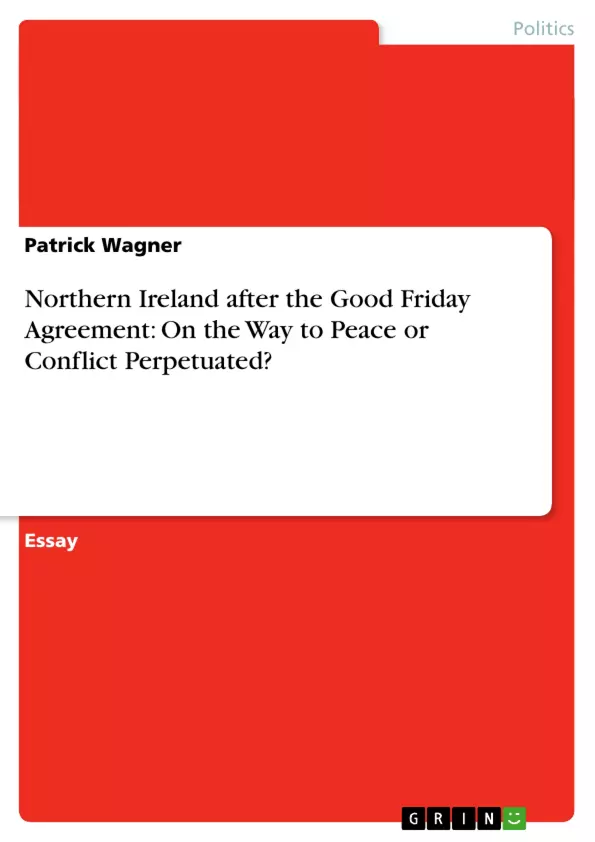Six years after the Good Friday Agreement was signed and after a promising, although troubled start of the institutional framework it has put in place, Northern Ireland is, following the suspension of devolution on 14 October 2002, yet again under direct rule from Westminster. Centuries of conflict, decades of violent troubles and diametrically opposed demands of the groups involved make the Northern Ireland question to one of the most difficult conflicts of our time. Nevertheless, there was genuine optimism both among the parties involved and the international community that the Agreement would succeed and resolve the conflict.
However, in the political reality of Northern Ireland, the Agreement soon reached its limits, and people realised that it takes more than an assembly and a power-sharing executive to overcome Ulster’s deep-rooted sectarian divisions. Internal disagreement in the unionist and nationalist camps over the direction the Agreement is likely to take them and the still unresolved question of IRA weapons decommissioning leave the future of the Agreement in serious doubt.
The Agreement has been widely acknowledged as being consociational and consistent with the four principles of power-sharing identified by Lijphart. This paper will thus also discuss the theoretical foundation of the Agreement. Here, it will particularly focus on the role of the voting system (Single Transferable Vote) employed for the Assembly elections, which is unusual for consociational models.
This paper will conclude that the Agreement is undeniably a major breakthrough. Even if the Agreement itself does not solve the conflict, by creating a prolonged period of peace in which political dialogue can take place, it could be a vital step towards a future settlement. But is the current situation in Northern Ireland really a transitional period likely to lead to a solution of the conflict in the future or is it what Trimble calls the ‘continuation of war by other means’?
The Agreement was certainly not an overall failure as it has managed to bring parties together in political institutions which have refused to sit together in the same room for decades. But its limitations must also be clear: the war might be over but the conflict is far from ended. Since the Agreement has failed to address the underlying issues of the conflict and merely regulates violence, it cannot be regarded as a permanent and sustainable solution.
Inhaltsverzeichnis (Table of Contents)
- Introduction
- The Parties and their Demands
- The Unionists
- The Nationalists
- The UK and the Irish Governments
- The Good Friday Agreement
- The Northern Ireland Assembly
- The Power-Sharing Executive
- The North-South Ministerial Council and the British-Irish Council
- Theoretical Perspective
- Transition, Solution or Failure?
- Conclusion
Zielsetzung und Themenschwerpunkte (Objectives and Key Themes)
This paper aims to analyze the Good Friday Agreement's effectiveness in addressing the demands of various groups involved in the Northern Ireland conflict. It further examines whether the agreement's institutional framework is suitable for regulating the conflict and achieving long-term peace.
- The demands and perspectives of key parties to the Northern Ireland conflict
- The institutional framework established by the Good Friday Agreement
- The theoretical underpinnings of the Agreement, particularly consociationalism
- The potential advantages and disadvantages of consociationalism in the Northern Ireland context
- Alternative approaches to conflict resolution, such as social transformation
Zusammenfassung der Kapitel (Chapter Summaries)
- Introduction: Introduces the context of the Northern Ireland conflict and the Good Friday Agreement, highlighting the agreement's initial promise and subsequent challenges.
- The Parties and their Demands: Provides an overview of the major groups involved in the conflict, outlining their respective identities and demands.
- The Good Friday Agreement: Analyzes the core elements of the Agreement, specifically focusing on the institutions established to address the conflict: the Northern Ireland Assembly, the Power-Sharing Executive, and the North-South Ministerial Council and the British-Irish Council.
- Theoretical Perspective: Examines the theoretical framework of the Good Friday Agreement, emphasizing its consociational nature and its alignment with the principles of power-sharing.
- Transition, Solution or Failure?: Discusses the potential benefits and drawbacks of a consociational approach in the Northern Ireland context. It explores alternative models like the social transformational approach and critically analyzes the Agreement's effectiveness in achieving lasting peace.
Schlüsselwörter (Keywords)
The paper focuses on the Good Friday Agreement, consociationalism, power-sharing, conflict regulation, Northern Ireland, sectarianism, unionism, nationalism, and the institutional mechanisms for peacebuilding. It analyzes the agreement's effectiveness in addressing the underlying issues of the conflict and its potential for achieving a sustainable and peaceful resolution.
- Quote paper
- Patrick Wagner (Author), 2004, Northern Ireland after the Good Friday Agreement: On the Way to Peace or Conflict Perpetuated?, Munich, GRIN Verlag, https://www.grin.com/document/26030



